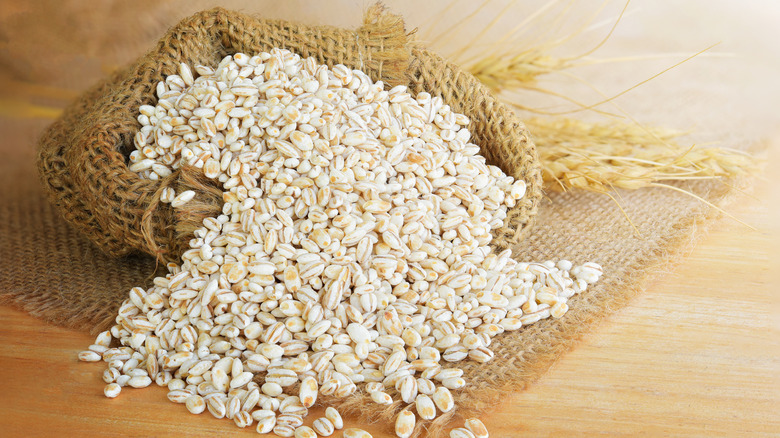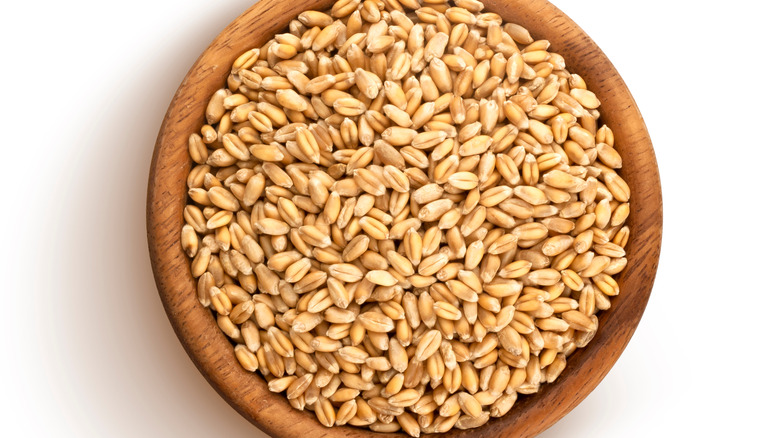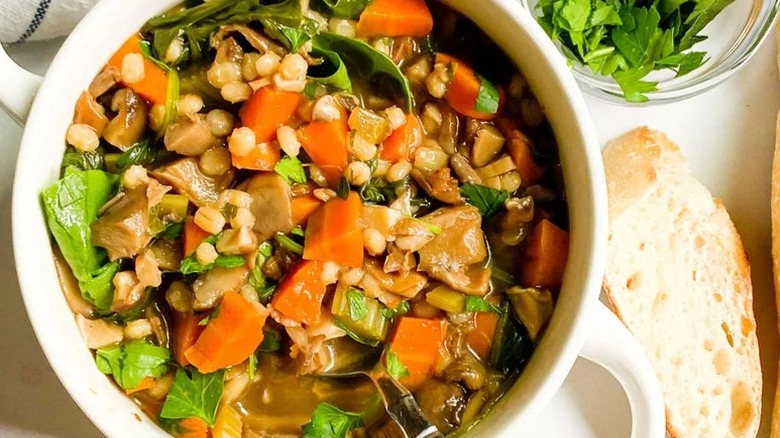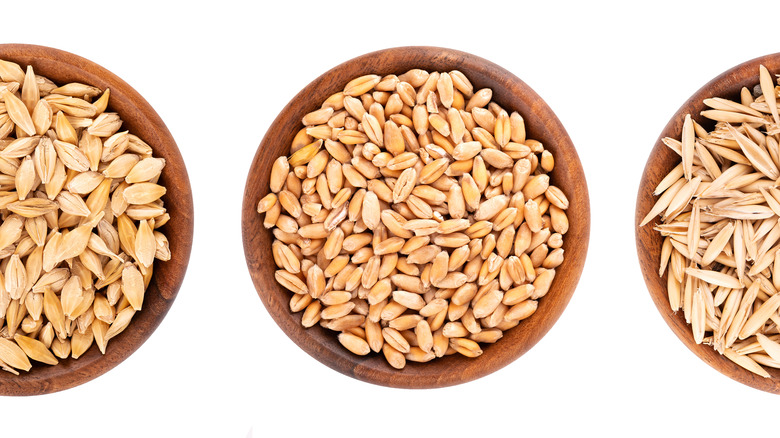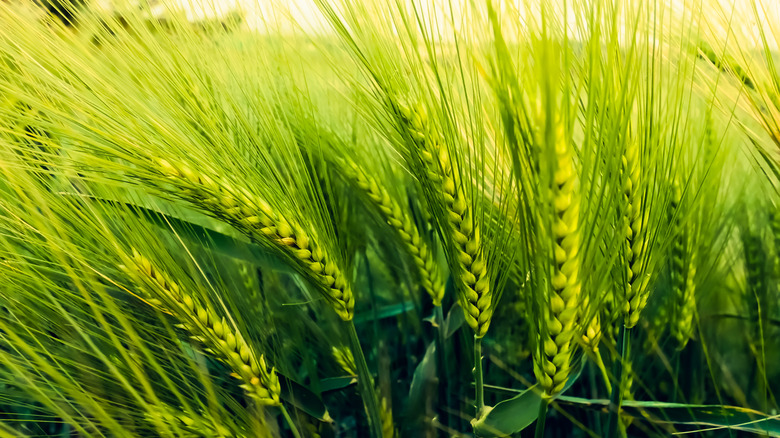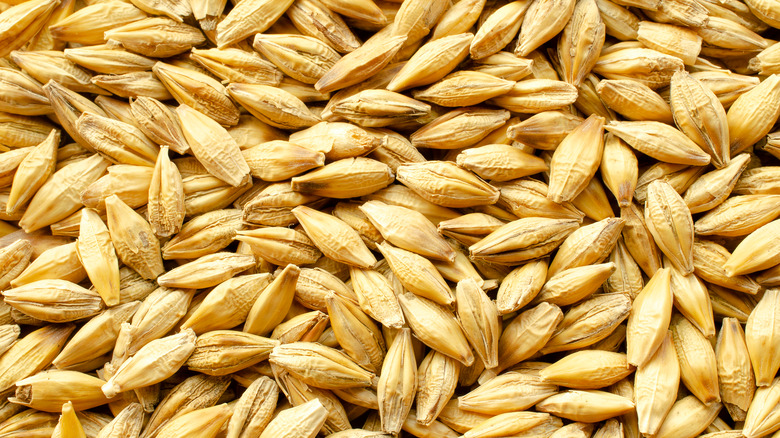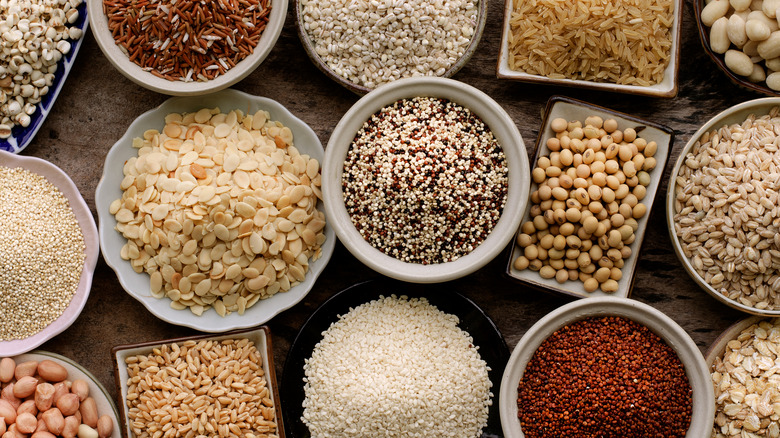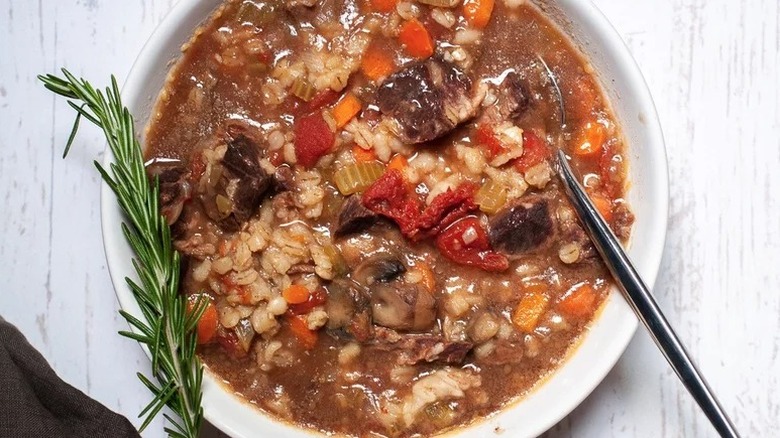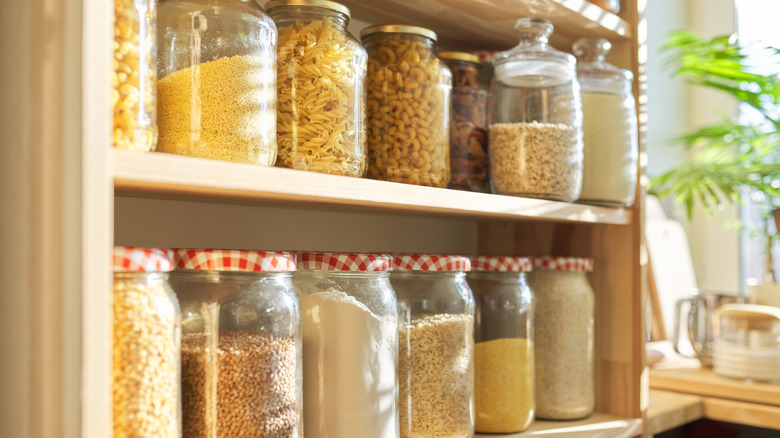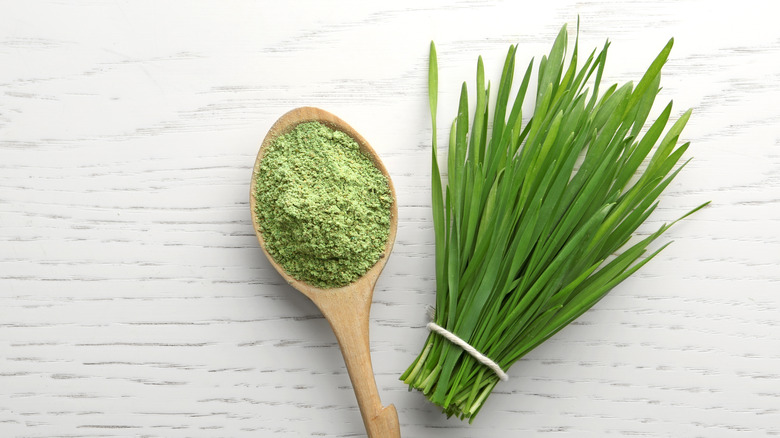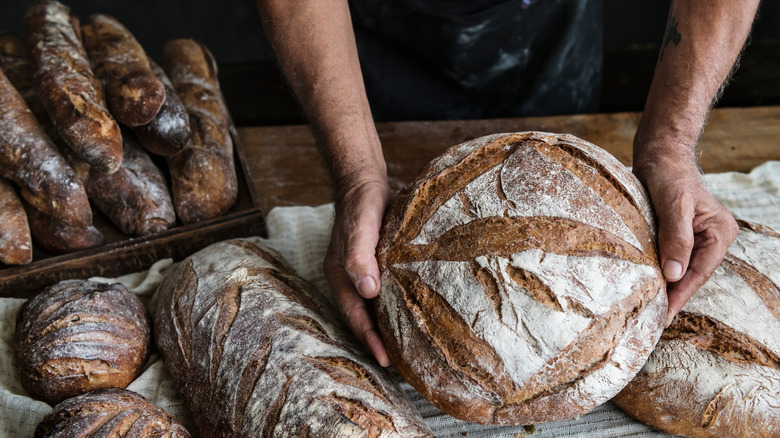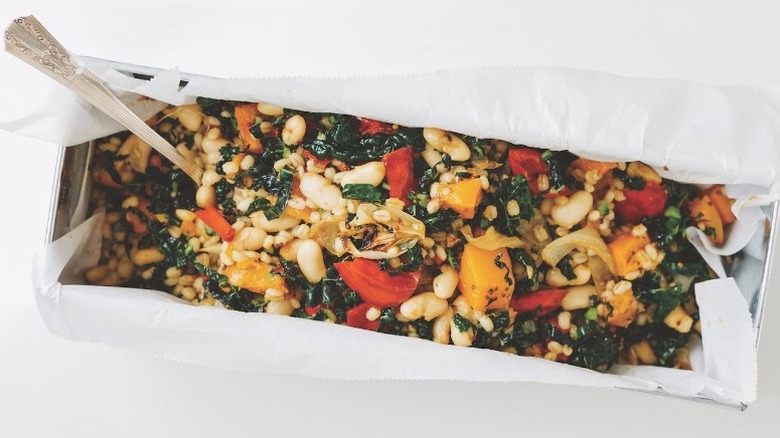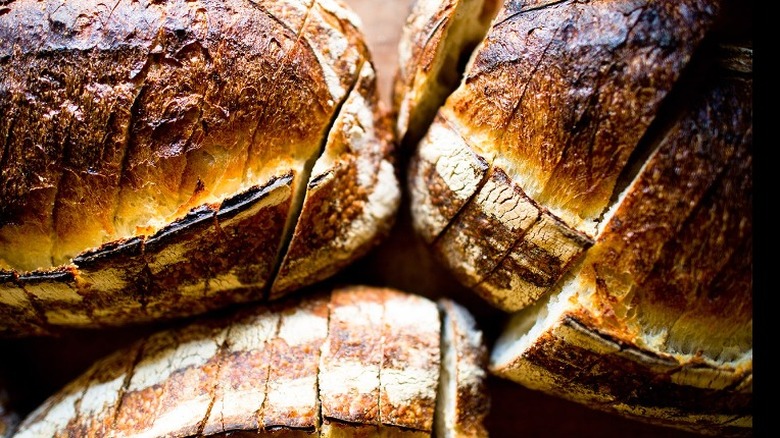Everything You Need To Know About Barley
The prominence of gluten-free diets has risen over the years and traditional grains have gotten somewhat of a bad rap. As they fall from grace, ancient varieties have been lifted up in their place. Grains like quinoa, kamut, and freekeh have become popular by offering lofty health claims, easy prep, and trendy names that impress house guests. Among the rush for new (old) types of food sources, there is one kernel often overlooked. This reliable ingredient meets many of the grain revolution's most nutritious promises. Plus, it's as ancient as they come. Barley may be old, but it still has a lot of life left.
Barley (Hordeum vulgare) doesn't deserve to be relegated to your grandparents' pantry. If the age-old history of barley isn't enough to inspire you to cook, consider the fact that barley is a vitamin and mineral dense food foundation, capable of filling your appetite and satisfying your taste buds. There's a lot to know about barley. Fortunately, the grain has a long, descriptive history.
While it's true that most barley in the U.S. goes to animal feed or beer production, it still makes up a significant human food source and can be found almost anywhere. So, where do you get barley, and what do you do once it's in your pantry? Keep reading for everything you need to know about the goodly grain.
What is barley?
Barley is an annual cereal grass and one of the oldest foodstuffs on the planet. As part of the grass Poaceae family (which also contains rye, rice, oats, corn, sugarcane, and all the various species of wheat), barley is considered among "the world's single most important source of food" (per Brittanica). It is the fourth largest grain crop after wheat, rice, and corn. According to Statista, 159.74 million tons of barley were produced this past crop year. Incredibly, the biggest consumer isn't humans. Up to 65% of barley production worldwide goes to feeding animal stock (via ScienceDirect). Livestock eat a variety of barley called six-row, which is higher in protein and thus more suited for animal feed.
The lower protein, higher sugar type of two-row barley is used for human consumption. Eating and drinking things made from barley is one of the oldest human traditions, and for centuries we've enjoyed it in soups, breads, and salads. We even drink it in tea, although tea isn't the largest barley drink being gulped worldwide.
Humans also have quite a taste for beer. The Encyclopedia of Food and Health reports that around 30% of the barley crop goes to malting the grain. That's nearly 48 million tons of barley being used for your favorite brews.
The history of barley
A report from "Molecular Biology and Evolution" reveals that the type of barley grown today was developed from the wild variety Hordeum spontaneum over 10,000 years ago. As Brittanica notes, barley was one of the first grains cultivated in the Fertile Crescent and ancient clay tablets demonstrate that Mesopotamia was growing barley as a domesticated crop between 3300-3100 B.C.
Barley grass is an adaptable cereal grain. A crop of it can grow and ripen to seed in just 90 days across a mix of subtropic, subarctic, and temperate regions. Because it can be grown and harvested quicker than other cereals, barley spread across Africa, the Himalayas, the Middle East, and Europe. Europeans brought it to North America, and Tibet is also believed to be an independent site of barley cultivation (per Brittanica).
Around the 16th century B.C., barley was the main bread crop for ancient Hebrews, Greeks, and Romans. As the University of Arizona notes, barley is used for the traditional kasha and murri foods that are served across Arabic, Turkish, Kurdish, and Persian regions of the world. It is used for porridge in Scotland and has been grown across Europe since the 5th millennia (per Evolutionary Biology). While eating barley gruel doesn't sound appetizing now, people have been doing it for centuries. Hopefully, the flavor has evolved over all that time.
What does barley taste like?
Despite the small worldwide percentage of barley that is grown for food, (2-3% per ScienceDirect), humans still count it among a chief foodstuff. So, what does barley taste like? The Med Munch note that barley has a nutlike flavor that has a real subtleness to it. According to Mashed, the subdued flavor combined with a slightly chewy texture make the grain a foundation comparable to brown rice or farro. The Spruce Eats says it can be used like quinoa and served with lentils.
As a result of its consistency and taste, barely can serve as a thickener that will minimally alter the flavor profile of a dish, and in some places, barley is used as a sweetener. In Japan, barley is roasted till slightly caramelized then steeped in hot water to make a savory tea called mugicha. Barley grains are a little more round than farro, with a resemblance closer to couscous than rice.
Barley varieties
Barley grain is technically a seed head, and so prior to being processed it comprises three main parts: the germ, the endosperm, and the husk (per University of Oregon). The methods of processing barley into an edible food source results in two types of consumable grains: pearl (or pearled) barley and hulled (or hull-less barley). Pearled and hulled barley are scientifically the same species so although they look different they are fairly similar. Hulled barley is the less processed version of the two which makes a significant difference in its nutritional value. All barley is non-GMO, according to Livestrong.
The Whole Grain Council notes that pearled barley is the more common grocery store option due to the fact that it cooks quicker than its hulled counterpart. Pearled barley has been scrub polished to remove the outer bran layer of the seed and whitens the barley kernel. As a result, it removes a large source of nutrition, and costs pearled barley the title of whole grain. Although it is a refined grain, pearl barley does saves you time at the stove — and for some people, that's a worthwhile tradeoff for vitamins and minerals.
Hulled barley is separated from a loose outer husk yet keeps the bran and germ intact. By not polishing the kernel during processing, the barley maintains whole grain status while also retaining a higher amount of crucial nutrients.
Is barley nutritious?
Barley is a nutritious grain that can give your body plenty of goods when eaten regularly. Hulled kernels do have more to offer in the way of micronutrients than pearled barley does, but both types have a lot to offer. When compared by the cup to other popular and ancient grains, it is clear that barley is right up there with the best superfoods.
Healthline notes that whole grain barley is a significant source of minerals like magnesium and phenolic acids. It is also high in vitamin B1, has eight essential amino acids, and is loaded with antioxidant lignans as well as soluble fibers called beta-glucan.
Consuming whole grain barley loaded with these compounds can help lower cholesterol and aid in the prevention diabetes, colon cancer, and heart disease. For example, magnesium plays a role in the body's insulin production, while lignons can help naturally curb appetite and give your gut bacteria something to feed on. Additionally, hulled barley has highly-soluble beta-glucan fibers which bind to "bad" LDL cholesterol, lowering the body's risk of heart disease. As for pearled barley, it is also high in fiber and carries a small amount of protein.
Is barley gluten-free?
What is gluten, and why is it the food buzzword of this century? According to Medical News Today, gluten is a category of proteins that are found in certain grains. Of the prominent proteins, it is gliadin that results in the most troubles for gluten-intolerant eaters. When people with Celiac disease or gluten sensitivity eat gluten, their body treats the proteins like an invader. The defense against gluten can result in inflammation, tiredness, rashes, and even tissue damage to the intestines. That said, it is important to know whether barley is gluten-free.
Healthline reports that barley is not gluten-free. Although barley is related to gluten-free heavy-hitters like rice and quinoa, it is more closely categorized with wheat and rye grasses (both of which come with various levels of gluten). Although barley does contain some gluten proteins it is approximately 5 to 8 percent gluten, whereas wheat is much higher.
Without a doubt, the prominence of Celiac disease has risen significantly in recent years. While that likely comes down to better diagnosing from doctors, there is a lot of conflicting research and information about the adverse health effects of eating gluten. The truth about gluten is that like many other things in life, it is best in moderation, unless of course you have a medical condition like Celiac — then it's best to leave it out altogether.
How barley compares to other grains
Ancient grains are making up more of the American diet, so how does barley compare to these hearty foodstuffs? As mentioned, barley contains gluten which separates it from grains like quinoa, amaranth, millet, rice, and some oats. Healthline notes that barley has less gluten than bulgur wheat. If gluten proteins aren't a concern for you then it is best to compare barley on nutritional values, as well as how it cooks.
According to Bob Red Mills, quinoa will provide more protein than barley, as well as more essential amino acids per gram. Additionally, barley and brown rice contain nearly identical amounts of fats and proteins. Good Housekeeping reports that a cup of barley contains more fiber than a cup of kamut and more calcium than brown rice. However, rice edges out barley when it comes to vitamin E and folate. Similarly, research shows that barley has fewer healthy phytochemicals per gram than rice or oats.
If you're in need of a quick foundation for your meal then stick with quinoa or amaranth grains as compared to barley. The first two will cook in around 15 minutes while hulled barley needs about an hour (per Bob's Red Mill). Rice cooks in around 35-45 minutes which falls right in between hulled barley and smaller grains. Pearled barley can cook in about the same time. Oats and cornmeal can also cook faster than barley, unless of course you are getting creative with your grain preparation.
Common ways to cook barley
Cooking both whole grain hulled or refined pearl barley is similar to cooking rice. The most common way to cook barley is to rinse the kernels and place them in a simmering pot of water at a 3:1 ratio of water to barley (per The Kitchn). The method may be common but the techniques ranges.
One example is rinsing your grains. A common way to serve barley is in soup or stew. As the food blog Kitchn writes, whether or not you rinse your cooked kernels will affect how much extra starch you'll have in the stockpot. If you need a thickener, consider simmering barley with your soup. For thinner concoctions, cook it separately. Hulled barley can simmer for one hour-plus and should be soft but not gummy. It retains a good shape (Kitchn recommends it for pilaf). Hulled barley won't take up as much liquid as pearled barley which needs to simmer around 40 minutes. Post-cooking tips from Delishably say to drain and steam barley for a couple minutes and fluff with a fork before serving.
The Los Angeles Times has an excellent suggestion to overcook pearl barley to make it a sweet or savory porridge. Hot cereal has long been a regular way to cook barley, but there are easier methods these days. Both hulled and the pearled barley can be found in a flake form similar to oatmeal. It's a fast and easy way to add hot barley to your mornings.
Where to get barley
Barley can be found easily at just about any grocery or health food store. Thrive Cuisine notes that you should check these three places in the supermarket to find your barley grains: First, the dried foods aisle (barley may be stocked alongside the rice and beans). If it isn't there, then you should next check the bulk section (provided your grocery store has bulk bins for various grains, seeds, and granolas). If you have failed to find barley in either of these sections then your final steps should be to look amongst hot cereals found in the breakfast aisle, or check in with the soup ingredients.
You can recognize pearl barley based on color (the refining process makes it almost pale white), or on size and shape (pearl barley is smaller, more round, and smooth). Meanwhile hulled barley will have a golden brown color, a longer shape, and rougher texture (via The Washington Post).
In addition to dried barley kernels, some health stores, supermarkets, and juice bars may sell powdered or even fresh barley greens. These green sprouts are a totally different way to get your barley fix.
How to store barley
Since barley grains tend to come dried, storage is simple. Make sure to buy grains that are well-packed and totally sealed. If you a bag of barley that has been ripped or does not have a proper seal consider moving it to a glass jar or Tupperware. Store these grains in an airtight container and keep it in a cool, dark place.
When it comes to hulled versus pearled barley, RecipeTips.com suggests that pearled barley will keep for longer than hulled barley since the germ-component of the whole grain can go rancid in storage. As hulled barley technically is a full seed, the shelf life is variable.
If the temperature is warm in your home consider storing barley in the fridge and always use the smell-test to determine freshness. Any rotten or spoiled smell coming from hulled barley grains will mean that the seed germ has gone bad. Typically, barley has a shelf life of up to one year.
Eating barley grass and sprouted barley
If dried barley grain is considered a superfood then barley grass is how it got its super powers. The small shoots are a common ingredient at juice shops and smoothie bars, and for good reason. Similar to the well-known health food wheatgrass, barley grass is packed with good green nutrients that boast big benefits.
Healthline cites barley grass as being high in several crucial vitamins. Barley has vitamin A which promotes and regulates the body's immune system and cell growth. There's vitamin K, crucial to heart, blood, and bone health. Barley grass is also high in vitamin C which is important for just about everything. Large amounts of polyphenols and flavonoids (two high-powered antioxidants) can also be found in barley grass. Along with these wholesome components, research suggests that barley grass also contains most of the same nutrients that barley grains do, just in an easier format for your body to uptake. Drinking barley grass can aid sleep, regulate blood sugar, and make digestion easier (per WebMD).
Maybe the best things about barley grass is that it can be grown indoors on a countertop (similar to micro greens), then used as an ingredient in the blender. One stage of growing barley grass is known for its own culinary value. Sprouted barley seeds can offer a tasty and nutritious middle-ground between barley greens and dried kernels, according to Penn State University. Soaked seeds can make plant milks, salad-toppers, or be ground into flour (per The Kitchn).
Baking with barley flour
Barley is the food source that keeps giving. In addition to fresh greens, sprouted seeds, and boiled grains, barley kernels are often ground into a flour and used for baking purposes of all kinds. Thanks to a low gluten content, the creations that can be made with barley flours are very unique. (Just remember, any baked barley good will not be gluten free.)
To get comfortable with barley baking, King Arthur Baking Company suggests replacing only a portion of your typical flour with barley flour. Incorporating a small amount of barley flour will result in a moist texture and a subtlety nutty flavor. In larger quantities, barley flour will make your recipe more crumbly. However, barley's low gluten content will mostly prevent your creations from getting a good rise in the oven. While that isn't great for cakes or pastry, you can still make quite a good flatbread. These pumpkin pecan pancakes are also a seasonal way to start using a new ancient grain ingredient.
What pairs best with the flavor profile of barley?
Barley has a mostly neutral, hidden flavor. Yet over the centuries humans have found some particular ingredients which greatly bring out the taste of barley grain, and others that build on top of it.
The Spruce Eats recommends pairing your barley with garlic, or serving it seasoned with cinnamon. Additionally, herbs like marjoram, parsley, and thyme can really add a deep herbaceous note to your base grains. Hot barley cereal goes as well with either sweet jams or fresh fruit as it does with breakfast meat and eggs. One savory dish is something your grandmother may have cooked: Beef and barley soup. This American favorite dates back to before settlers even left Europe. There are excellent vegetarian takes on this classic dish as well, so enjoy it however you like. In addition to soups, barley can add grounding, filling volume to any salad, especially one with roasted vegetables.
Other uses for barley
As mentioned earlier, the mass amount of barley produced for human consumption isn't eaten as much as it's drunk. Worldwide, beer is the biggest human-based use for barley — at least it is if you don't count the fact that humans eat the animals that eat the feed barley. That said, millions of pounds of barley are fermented into malt grains per year in order to satisfy civilization's thirsts. These days, inventive beer makers are even finding ways to take the gluten out of barley beer. When they do, the spent grains can be turned into snacks, breads, and other goods. Craft brewers across the country have started getting into the trend of turning used grains into beer pretzels too. The lack of sugar in the grains highlight a new, earthy flavor that brings out the nutty notes and goes great with pub cheese.
As it turns out, you can still teach old barley new tricks.
